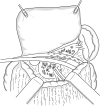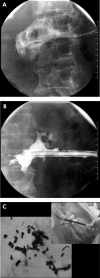Management of acute pancreatitis: from surgery to interventional intensive care
- PMID: 15710995
- PMCID: PMC1774421
- DOI: 10.1136/gut.2003.035907
Management of acute pancreatitis: from surgery to interventional intensive care
Figures




Similar articles
-
Percutaneous endoscopic necrosectomy in a patient with emphysematous pancreatitis: A case report.Medicine (Baltimore). 2021 Nov 19;100(46):e27905. doi: 10.1097/MD.0000000000027905. Medicine (Baltimore). 2021. PMID: 34797345 Free PMC article.
-
Minimally invasive necrosectomy using resectoscope for intractable necrotic abscess after severe acute pancreatitis: report of a case.Surg Today. 2015 Nov;45(11):1442-5. doi: 10.1007/s00595-014-1063-5. Epub 2014 Nov 11. Surg Today. 2015. PMID: 25382168
-
[Surgical intervention strategy for severe acute pancreatitis in minimally invasive era].Zhonghua Wai Ke Za Zhi. 2019 Oct 1;57(10):6-10. doi: 10.3760/cma.j.issn.0529-5815.2019.10.002. Zhonghua Wai Ke Za Zhi. 2019. PMID: 31510725 Chinese.
-
Minimally invasive endoscopic treatment of necrotizing pancreatitis: A case report with images and review of the literature.Rev Assoc Med Bras (1992). 2017 Mar;63(3):207-209. doi: 10.1590/1806-9282.63.03.207. Rev Assoc Med Bras (1992). 2017. PMID: 28489122 Review.
-
Severe acute pancreatitis for the acute care surgeon.J Trauma Acute Care Surg. 2016 Jun;80(6):1015-22. doi: 10.1097/TA.0000000000001029. J Trauma Acute Care Surg. 2016. PMID: 26953759 Review. No abstract available.
Cited by
-
Gastric perforation without generalized peritonitis; A very rare complication after necrosectomy for necrotizing pancreatitis.Pak J Med Sci. 2016 May-Jun;32(3):782-5. doi: 10.12669/pjms.323.9726. Pak J Med Sci. 2016. PMID: 27375733 Free PMC article.
-
Focused open necrosectomy in necrotizing pancreatitis.HPB (Oxford). 2013 Jul;15(7):535-40. doi: 10.1111/hpb.12004. Epub 2012 Nov 22. HPB (Oxford). 2013. PMID: 23458703 Free PMC article.
-
Severe Acute Pancreatitis - How Conservative Can We Be?Visc Med. 2018 Dec;34(6):432-434. doi: 10.1159/000494097. Epub 2018 Nov 17. Visc Med. 2018. PMID: 30675488 Free PMC article. Review.
-
Summary of integrative medicine for severe acute pancreatitis: 26-year clinical experiences and a report of 1 561 cases.Chin J Integr Med. 2011 May;17(5):381-5. doi: 10.1007/s11655-011-0607-4. Epub 2011 May 25. Chin J Integr Med. 2011. PMID: 21611903
-
Surgery for Acute Pancreatitis.Indian J Surg. 2015 Oct;77(5):446-52. doi: 10.1007/s12262-015-1357-x. Epub 2015 Oct 13. Indian J Surg. 2015. PMID: 26722210 Free PMC article.
References
-
- Isenmann R, Beger H. Natural history of acute pancreatoitis and the role of infection. Baillieres Best Pract Res Clin Gastroenterol 1999;13:291–301. - PubMed
-
- Klar E, Werner J. New pathophysiological findings in acute pancreatitis. Chirurgia 2000;71:253–64. - PubMed
-
- Buter A, Imrie C, Carter C, et al. Dynamic nature of early organ dysfunction determines outcome in acute pancreatitis. Br J Surg 2002;89:298–302. - PubMed
-
- Gloor B, Muller CA, Worni M, et al. Pancreatic infection in severe pancreatitis: The role of fungus and multiresistent organisms. Arch Surg 2001;36:592–6. - PubMed
-
- Dervenis C, Johnson CD, Bassi C, et al. Diagnosis, objective assessment of severity, and management of acute pancreatitis. Int J Pancreatol 1999;25:195–200. - PubMed
Publication types
MeSH terms
LinkOut - more resources
Full Text Sources
Medical
